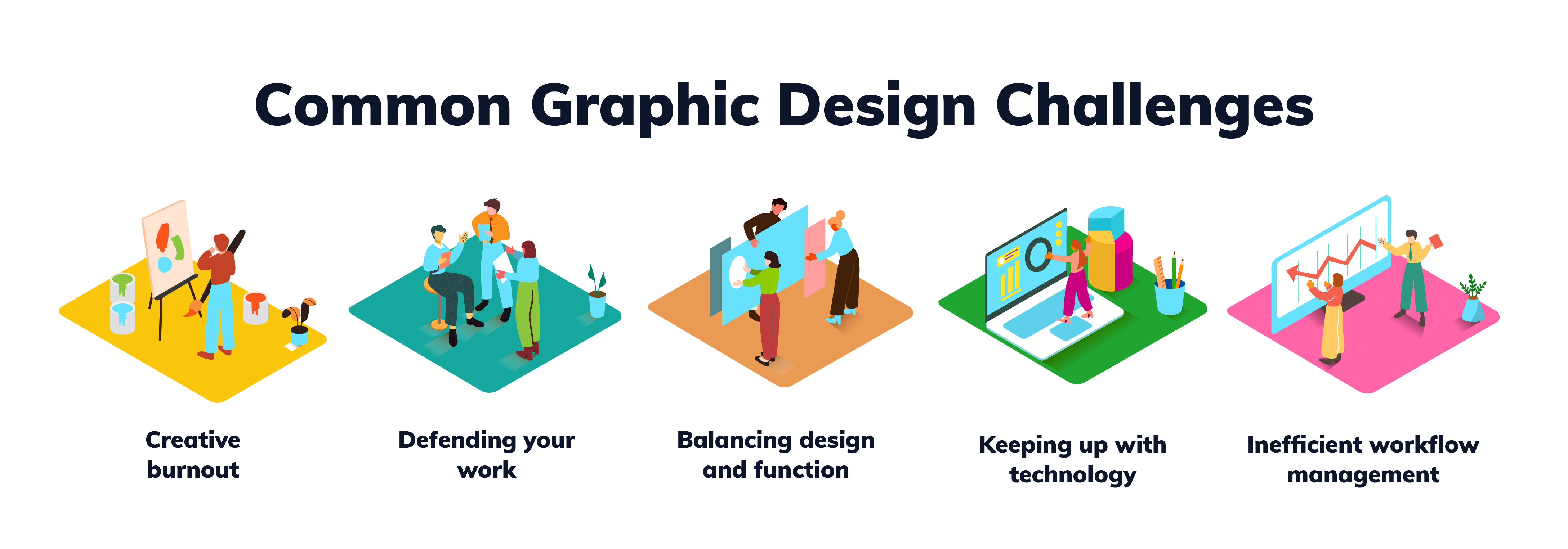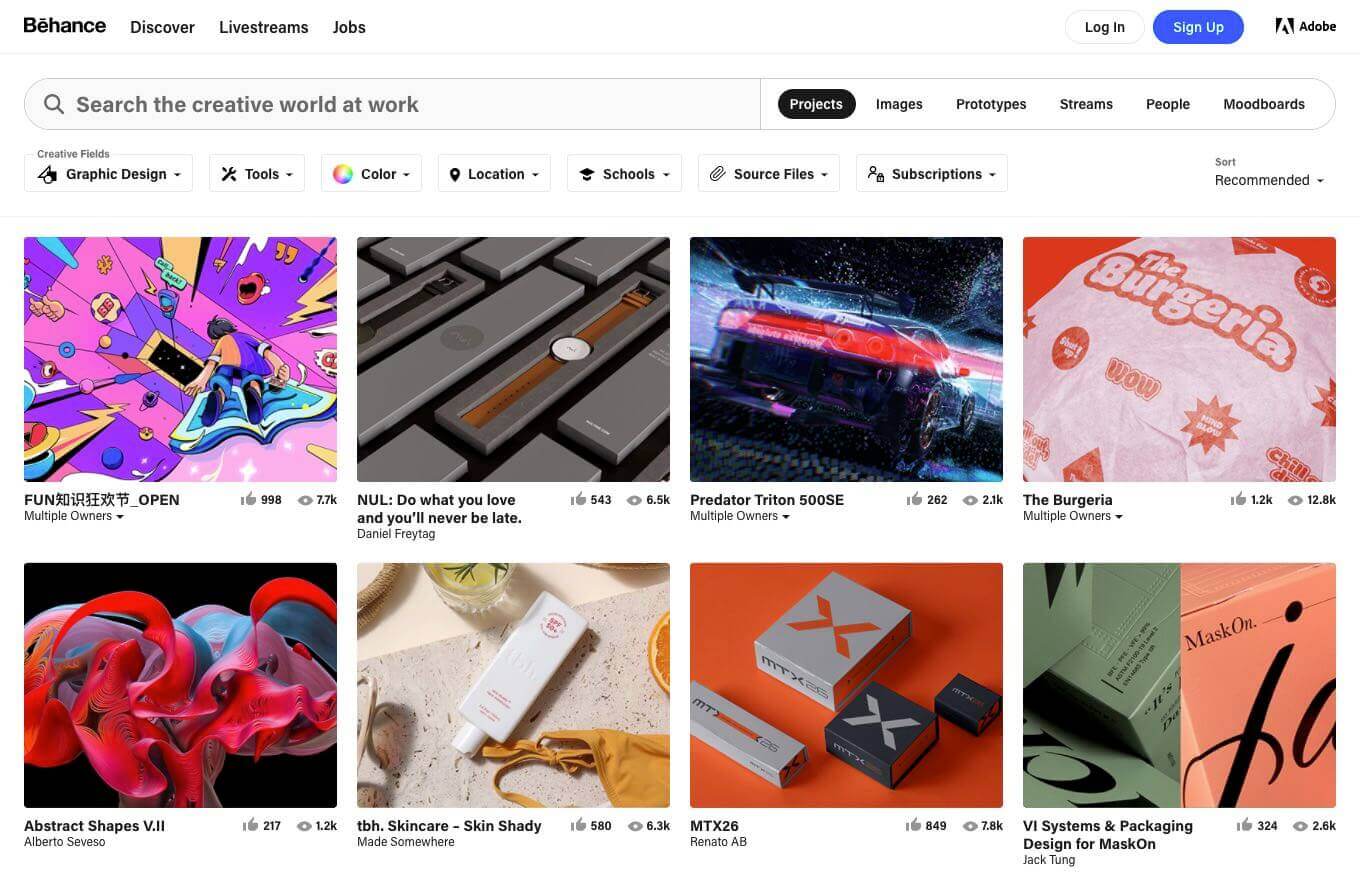

The Most Common Graphic Design Challenges Designers Face
Every creative process has its setbacks. Learn about the biggest graphic design problems and how to resolve them!

.svg)
What challenges do graphic designers face? How difficult are these graphic design challenges, and what’s the best way to overcome them? Here’s the full scoop!
Graphic designers are one of the most sought-after professions nowadays since graphics are an inevitable part of any modern business. But no matter how experienced a professional they ar, there are some challenges faced by graphic designers that are simply part of the creative process.
Are you a designer looking to overcome creative challenges? Or a design client that wants to understand the challenges in graphic design to better approach the process? Then keep reading!

{{GRAPHIC_BANNER="/dev/components"}}
1. Creative Burnout
Creative burnout is one of those challenges faced by graphic designers that’s particularly difficult to understand for demanding clients. A doctor can’t say they don’t “feel” like operating on someone. A sales rep won’t stop working the moment they don’t feel particularly talkative or persuasive.
And yet, it’s perfectly normal for designers to feel that sometimes the ideas simply aren’t flowing. A seasoned professional will always be able to design something, but if the inspiration isn’t there, the graphics will probably feel quite dull and unoriginal.
How to overcome this challenge?
At times, creative burnout is a direct outcome of doing something repeatedly in the absence of other creative outlets. Therefore, finding a different way to express your creativity can be a way to get ideas and even some graphic design practice. Similar disciplines, such as painting, photography, or sculpture are all great choices.
Another short-term solution, as with any other profession, is to connect with people from the graphic design industry. Creative professionals can ask more informed questions than clients requesting graphic design. In turn, this can point to a different direction or perspective you haven’t thought of.
Finally, there are many great places to find creative inspiration: from great design blogs, to portfolio and social media platforms. You can also use design prompt generators to give you ideas what to create.

2. Defending your work
Is graphic design challenging? This is at least one reason why all designers will say “yes”.
When there’s no mathematical formula to calculate the success of a piece of design, defending your work and creative decisions can be quite tricky. Most graphic designers work with non-designers (90% of them work freelance, while only 18% work in ad and design agencies). So, one of the most common graphic design problems is dealing with unsolicited opinions and cringeworthy requests, such as “Can you make it pop”, or “Let’s use up this empty space”.
Keeping your head down and going along with every request that goes against the most basic design principles is a bad idea. This doesn't just diminish your professional integrity (other people might see the work and think you can’t do better). As you probably know, bad design can seriously harm your client’s brand image, and it’s your job to warn them against common graphic design mistakes.
How to overcome this challenge?
We have a whole blog post on how clients should provide actionable and useful feedback to graphic designers. Let’s hope your next client reads it!
Alternatively, here are a few things you can do to overcome this graphic design challenge:
- Ask questions: It may sound like a cliche, but sometimes people just want to feel heard. Instead of dismissing the client’s wishes as unreasonable, dig deeper to find out why they feel and think the way they do.
- Present data: Your client doesn’t like a blue logo? Tell them that 40% of Fortune 500 companies use this color in their logos. While there may not always be handy data on hand to back your claims, you can also use case studies and previous work to show why a certain approach works.
- Offer alternatives: Sometimes a client will ask for a change of direction simply because they haven’t been given any options to choose from. Make sure you submit several variations (most commonly different colors) to the client, as this might avoid clashes with them.
- Find a compromise: At the end of the day, this is one of those graphic design challenges that’s easily resolved through compromise. Instead of accepting all your client’s wishes, find a way to merge their vision into yours. Don’t forget that good communication is one othe most vital graphic design skills.
3. Balancing design and function
What’s more important in design: aesthetics or functionality? The answer is - it depends. In some areas of graphic design, such as user interface and user experience design, functionality is probably the most vital concern. On the other hand, if a logo design or social media post doesn’t stand out from the crowd, it’s probably not a very successful piece of design.
Looks and usability are critical aspects of graphic design. But striking the right balance or between the two is one of the most difficult problems graphic designers face.
How to overcome this challenge?
A very simple rule of thumb to follow is that usability trumps aesthetics. It may seem like an odd claim to make, especially coming from a graphic design company. Still, at the end of the day, the difference between graphic design and art is precisely that graphic design always serves a particular purpose.
If an ad is failing to get clicks, and a website leaves users frustrated and baffled, no amount of groundbreaking design can help.
Another simple rule to make a useful design well presented is to follow brand guidelines. Not all brands will have the most beautiful brand identity design. Nevertheless, so long as the brand’s identity is created with a specific target audience in mind, consistency will help build customer loyalty and boost brand recognition.
4. Keeping up with the technology
A few decades ago graphic designers still worked with pens and paper. Nowadays, there seem to be never-ending advancements in terms of graphic design software that enhance the possibilities of modern graphic design.
Of course, nowadays it would be impossible not to mention the rise of AI in graphic design: whether it’s a logo design or a social media post, many people are already using this modern technology, often as a way of avoiding the cost of professional graphic design.
How to overcome this challenge?
Is graphic design challenging? This problem certainly suggests so. You don’t just need to learn about all the new design programs and features that seem to be a daily occurrence. These days, lots of graphic designers feel they need to prove they’ll still be needed in the age of AI-generated design.
So, how to solve one of the most complicated challenges graphic designers face? Here are a few tips:
- Be a true master of a select number of programs: Spreading yourself thin by trying to master every design program will end up badly. There will always be a designer more proficient than you, and there’s no way you can keep up with all the trends and updates at all times. Pick a few programs that are most relevant to the type of design you specialize in, and keep learning and exploring their features.
- Stay in the loop: While you shouldn’t waste your energy taking a new graphic design course every week, it’s important to keep informed. Subscribe to relevant design industry blogs or publications to stay in the know about relevant design trends.
- Use AI to your advantage: You may not like it, but AI is here to stay. Although it won’t replace human designers yet, it can be a tremendous help in creating custom design quicker. But, it can be a tremendous help in creating custom design quicker. Whether you want to get some design ideas or simple design elements you can incorporate into your project, use this technological advancement as a supplement to your craft.
5. Inefficient workflow management
If hell is other people, then this is one of the common challenges in graphic design that proves it. Like most other creatives, graphic designers usually work as a part of a larger team. Therefore, they often face the usual challenges of teamwork, such as miscommunication or chasing impossible deadlines.
How to overcome this challenge?
The first thing you have to do if you’re unhappy with the way your work is structured is to revise your personal workflow. You might have been procrastinating, or even working at times that don’t work for you (some people simply work better outside of “usual” office hours).
An efficient workflow also means that you know exactly how much time and effort you spend on each individual task. A design project management team can help delegate tasks and oversee production.

In that respect quality assurance processes can really help with daily design challenges. This means checking that all aspects of design align with the creative brief, brand identity, and fulfill the purpose of the design.
Experience is the best teacher
Whether you’re drained for good design ideas, or have to deal with unreasonably short deadlines, remember that these are all challenges faced by graphic designers regularly. We hope some of our tips help you overcome them!
If you happen to be a client that’s not satisfied with the work of your designer, it pays to understand the ins and outs of the design process and the common challenges in graphic design. Do you want to keep exploring this topic? Here are some helpful resources:
- Make sure you understand what makes good design to distinguish it from the bad.
- Learn how to give constructive feedback to your designers.
- Make sure you have a solid understanding of the basic design principles, as these form the basis of any design project.
- Check out some of our tips to make the design process faster.
Having lived and studied in London and Berlin, I'm back in native Serbia, working remotely and writing short stories and plays in my free time. With previous experience in the nonprofit sector, I'm currently writing about the universal language of good graphic design. I make mix CDs and my playlists are almost exclusively 1960s.
A design solution you will love
Fast & Reliable
Fixed Monthly Rate
Flexible & Scalable
Pro Designers






.jpg)

